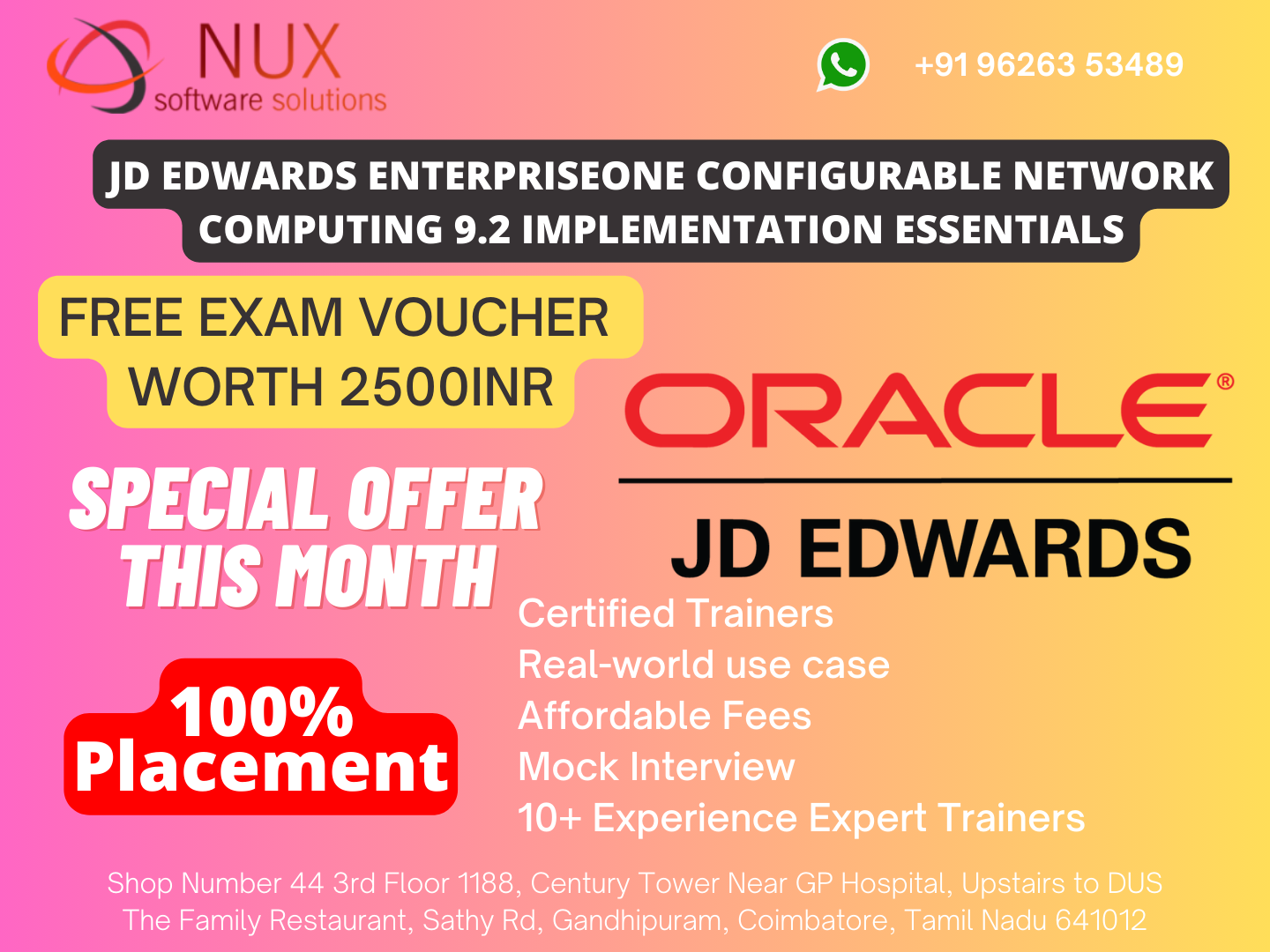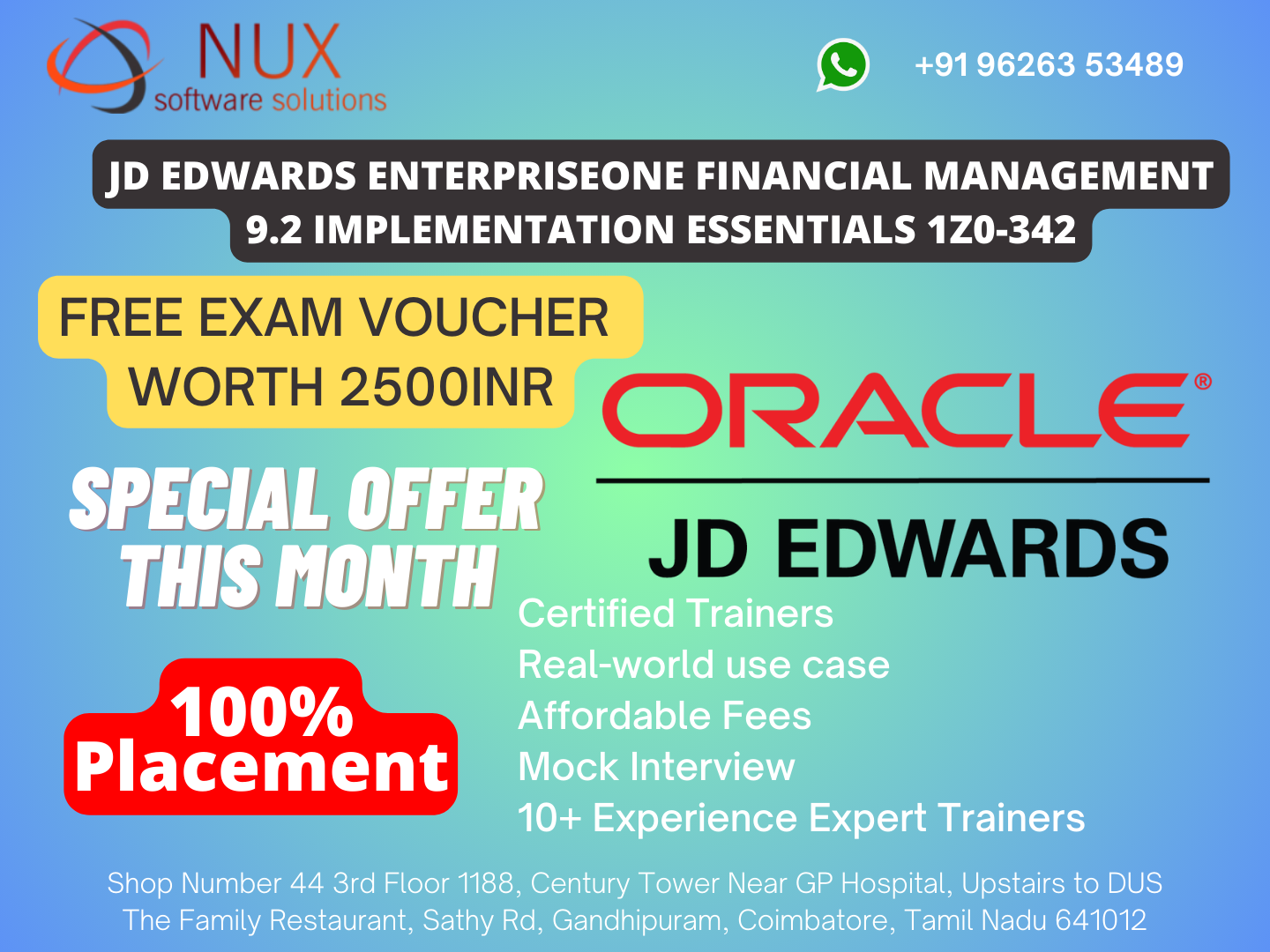Oracle PL/SQL Developer Certified Associate Certification


Best Oracle PL/SQL Developer Certified Associate Certification training courses classes deliver by Nux software solutions in coimbatore. Nux software solutions in coimbatore has excellent and advanced training programs that will give you better performance & hands on experience. Our industry’s expert trainers offer a wide range of skills and experience in their graded areas.
The Training center environment is too good for professional, individual, corporate, live project training and industrial training. Labs infrastructure is advanced, well managed and you can access LAB 24X7 from anywhere. Training center has international expert trainers and they have excellent knowledge, real time industry experience.
Our Training programs combine with several innovative learning methods and delivery models. We understand your requirement and it will give you 100 percent growth for your career and provide the cost effective training programs and also work with flexibility for the trainees.
The Oracle Certification Program certifies candidates on skills and knowledge related to Oracle products and technologies.
Credentials are granted based on a combination of passing exams, training and performance-based assignments, depending on the level of certification. Oracle certifications are tangible benchmarks of experience and expertise that Oracle claims to help a participant stand out in a crowd among employers.
Course Syllabus
Module
- Explain the need for PL/SQL
- Explain the benefits of PL/SQL
- Identify the different types of PL/SQL blocks
- Output messages in PL/SQL
- Declaring PL/SQL Variables
- Recognize valid and invalid identifiers
- List the uses of variables, declare and initialize variables, use bind variables
- List and describe various data types using the %TYPE attribute
- Writing Executable Statements
- Identify lexical units in a PL/SQL block
- Use built-in SQL functions in PL/SQL and sequences in PL/SQL expressions
- Describe when implicit conversions take place and when explicit conversions have to be dealt with
- Write nested blocks and qualify variables with labels
- Write readable code with appropriate indentation
- Interacting with the Oracle Database Server
- Create PL/SQL executable blocks using DML and transaction control statements
- Make use of the INTO clause to hold the values returned by a SQL statement
- Writing Control Structures
- Identify the uses and types of control structures (IF, CASE statements and expressions)
- Construct and identify loop statements
- Apply guidelines when using conditional control structures
- Working with Composite Data Types
- Create user-defined PL/SQL records
- Create a record with the %ROWTYPE attribute
- Create an INDEX BY table and INDEX BY table of records
- Describe the differences among records, tables, and tables of records
- Using Explicit Cursors
- Distinguish between usage of implicit and explicit cursors, use SQL cursor attributes
- Declare and control explicit cursors, use simple loops and cursor FOR loops to fetch data
- Declare and use cursors with parameters
- Lock rows with the FOR UPDATE clause and reference the current row with the WHERE CURRENT OF clause
- Handling Exceptions
- Define PL/SQL exceptions
- Recognize unhandled exceptions
- Handle different types of exceptions (pre-defined exceptions, non-predefined exceptions and user-defined exceptions)
- Propagate exceptions in nested blocks and call applications
- Creating Stored Procedures and Functions
- Differentiate between anonymous blocks and subprograms
- Create a simple procedure and invoke it from an anonymous block
- Create a simple function
- Create a simple function that accepts a parameter
- Differentiate between procedures and functions
MODULE 2 :
Oracle Database 11g: Develop PL/SQL Program Units
- Creating Procedures
- Differentiate between anonymous blocks and subprograms, use a modularized and layered subprogram design, and identify the benefits of subprograms
- Create a simple procedure and invoke it from an anonymous block
- Work with procedures
- Handle exceptions in procedures, remove a procedure, and display a procedure's information
- Creating Functions
- Differentiate between a procedure and a function
- Describe the uses of functions
- Work with functions (create, invoke and remove functions)
- Creating Packages
- Identify the benefits and the components of packages
- Work with packages (create package specification and body, invoke package subprograms, remove a package and display package information)
- Working with Packages
- Overload package subprograms, use forward declarations
- Create an initialization block in a package body
- Manage persistent package data states for the life of a session and use PL/SQL tables and records in packages
- Using Oracle-Supplied Packages in Application Development
- Describe how the DBMS_OUTPUT package works
- Use UTL_FILE to direct output to operating system files
- Describe the main features of UTL_MAIL
- Using Dynamic SQL
- Describe the execution flow of SQL statements
- Use Native Dynamic SQL (NDS)
- Use the DBMS_SQL package
- Design Considerations for PL/SQL Code
- Create standard constants and exceptions
- Write and call local subprograms
- Control the run-time privileges of a subprogram
- Perform autonomous transactions
- Use NOCOPY hint, PARALLEL ENABLE hint and DETERMINISTIC clause
- Use bulk binding and the RETURNING clause with DML
- Creating Triggers
- Describe different types of triggers and their uses
- Create database triggers
- Manage triggers
- Creating Compound, DDL, and Event Database Triggers
- Create triggers on DDL statements
- Create triggers on system events
- Using the PL/SQL Compiler
- Describe the new PL/SQL compiler and features
- Use the new PL/SQL compiler initialization parameters
- Use the new PL/SQL compile time warnings
- Managing PL/SQL Code
- Describe and use conditional compilation
- Hide PL/SQL source code using dynamic obfuscation and the Wrap utility
- Managing Dependencies
- Track and manage procedural dependencies


